1914
Studio Publicity
1914
William Fox Distributes Balboa Films
January: The Moving Picture World, “Fox Gets Balboa Pictures”; before William Fox created his own production company in 1915, Fox Films, he was a successful film distributor, and this article explains the important deal made with Fox to distribute exclusively Balboa films: “Through Box Office Attractions Company Makes Big Deal With H. M. Horkheimer, President of the Producing Co.”: The most important film deal that has been negotiated in some time was consummated in New York last week by H. M. Horkheimer, president and general manager of the Balboa Amusement Producing Company of Long Beach, Cal., and William Fox, of the Box Office Attraction Company, of 130 West 46th Street. The Balboa Company was organized about a year ago and is practically unknown in the East because of the fact that its product was marked under the brands of other companies to which it sold its productions. It first became known through an arrangement with Jack London to produce pictures based upon that writer’s stories, but a disagreement between parties arose and that agreement was abrogated after an amicable settlement had been made. Thereafter the Balboa Company continued to make pictures for several of the leading producing companies awaiting the time when a market for its product under the firm name should appear.
It was for this purpose that Mr. Horkheimer came to New York about four weeks ago with one hundred thousand feet of negative to show to the buyers at this point. After showing some of his product it became evident to all who saw it that the Balboa pictures were considerably above the average and a lively competition to secure that company’s output was the result. It was only after considerable negotiation that William Fox secured it for the Box Office Attractions Company (BOA). Last week the papers were drawn and signed by all parties, which gives the latter company exclusive control of all Balboa productions and puts that company squarely on the map. Mr. Fox’s contract covers North and South America and the West Indies and is estimated to amount in the aggregate to $625,000 annually.
British Company to Distribute Balboa Films
January (continues): The Moving Picture World, “Fox Gets Balboa Pictures”In addition to his contract with the Fox interests, Mr. Horkheimer secured a contract from Sidney Bishop for the European rights to the Balboa product, which should yield another quarter of a million annually, so he is returning home fairly well satisfied with the result of his visit to New York.
The Balboa Amusement Productions Company is capitalized for $500,000. H. M. Horkheimer is its president and general manager and his brother, E. D. Horkheimer, is secretary and treasurer. The company’s plant is at Long Beach, Cal. and covers about three acres at Sixth and Alamitos Streets. The studio stage is 100 by 150 feet and is well equipped with properties and scenery. Three producing companies are employed, with Bert Bracken and Henry Otto as principal directors.
Robert Brotherton, a former Selig technical man, has charge of the photographic laboratories and William Beckway is chief cameraman. The scenario department is in charge of Clifford Howard, a writer of stories of merit and a very competent man in his position. By Mr. Horkheimer’s contract with Mr. Fox his pictures will be featured as Balboa Feature Films, the Pictures Beautiful. The first release wil be ready for distribution ina about a week and will be a six-part subject entitled “St. Elmo.”
Mr. Horkheimer tells a very interesting story of his struggle to establish his business and pays a high compliment to the loyalty of his department heads and employees generally, without whose personal sacrifices he freely admits he would not have been able to keep up the fight. Balboa features will be awaited with interest.
St. Elmo
St. Elmo, the movie based on the popular Southern novel by the same name, by Augusta Evans, was released the summer of 1914, the novel having had more readers, Uncle Tom’s Cabin excepted, than any other fictitious narrative ever written by an American woman at that time. Motion Picture News (July 11, 1914) said the photography was excellent, something one expected from a Balboa production. Moving Picture World (July 4, 1914) also praised the movie and its photography.
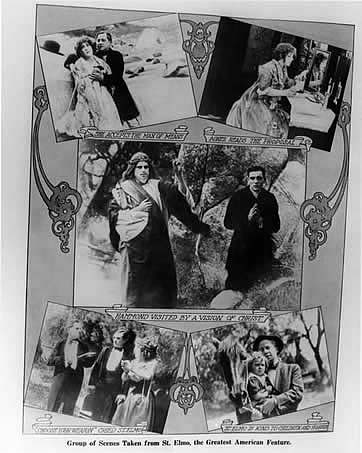

Photos, courtesy of Marc Wanamaker
Balboa Picture Breaks Records
A Will o’ the Wisp, Columbia Theatre, Long Beach
July: The Moving Picture World (“Balboa Picture Breaks Records”): Breaking all former records in big box office receipts at the Columbia Theatre in Long Beach, California, the Balboa Amusement Producing Company’s four-reel feature film, “A Will o’ the Wisp,” was shown at the playhouse named last Monday, Tuesday and Wednesday. In the four years since the theater was instituted there never before had been such a great crush of theater-goers, blocking the doors and massing in crowds for several hundred feet from the entrances…During the three afternoons and evenings this week, the services of city firemen and policemen were necessary to hold the throngs in check at the theater doors, and hundreds were turned away daily because the playhouse was not large enough to seat the hosts of eager pleasure seekers. On Tuesday evening several women were hurled to the pavement by the press of the surging crowds and for a time it seems they would be seriously injured, but were rescued by three policemen and carried outside the throng.
Great local interest was shown concerning the big release because of it being in every way a home product, being filmed at the Long Beach studios of the Balboa company and in the river lowlands near the northwest limits of the city, at a time when the country there was inundated by a river flood. The scenario was written by the Balboa photoplay editor, Frank M. Wiltermood, who borrowed the main idea of the play from the old-time melodrama, “Hazel Kirke,” showing an aged, blind man alone in his home while a storm rages outside. Among the highly talented players who enacted the leading parts in the masterpiece film were Jackie Saunders, Henry King, Dick Johnson, Mollie McConnell, Charles Dudley and Madeline Pardee.
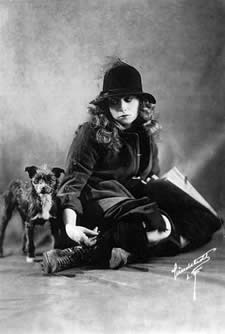
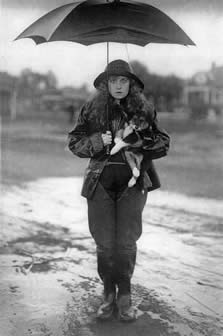
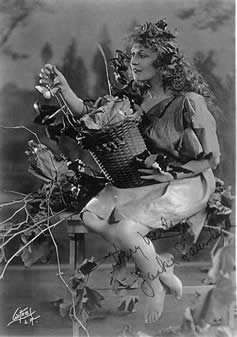
Jackie Saunders in publicity shots from A Will o’ the Wisp, photos courtesy of Mark Wanamker.
Contract with Pathé Frères, Paris
October: Before signing the contract in Paris, December 1914, the Horkheimers made public their association with Pathé Frères, Balboa being one of the first independent producers in the United States working for Pathé Frères, supplying four of the early serials with Pathé’s famous Golden Rooster trademark: Neal of the Navy, The Red Circle, The Neglected Wife, and Who Pays?
Bishop, Pessers & Co., Ltd., London
December: During Elwood D. Horkheimer‘s visit to New York, he conferred with Henry Pessers, director of Bishop, Pessers & Co., Ltd., of London, arranging several marketing deals for European distribution, renewing a contract to handle Balboa Feature Films in Great Britain, with possible agreements to market Balboa pictures in India, South Aftrica, Australia and other parts of the British Empire.
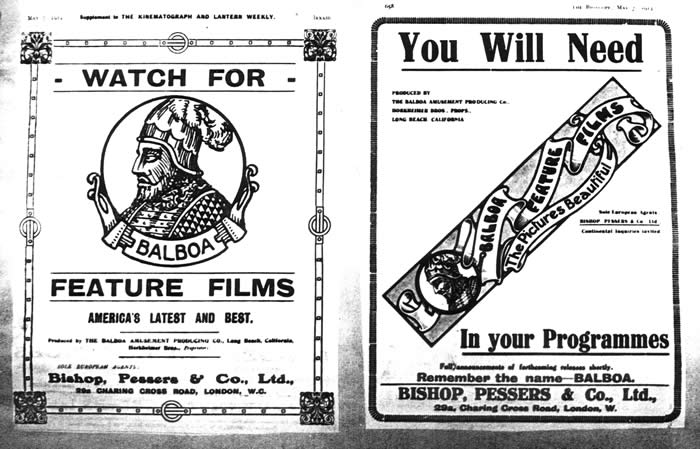
Photos, courtesy of Marc Wanamaker
